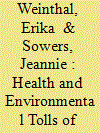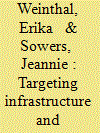|
|
|
Sort Order |
|
|
|
Items / Page
|
|
|
|
|
|
|
| Srl | Item |
| 1 |
ID:
181867


|
|
|
|
|
| Summary/Abstract |
The effects of conflict on public health and ecosystem well-being are understudied and rarely figure in public debates about war-making. Protracted conflicts are particularly damaging to people and environments in ways that are inadequately documented. In recent wars in the Middle East and North Africa, parties to the conflicts have induced hunger and displacement and undermined public health through the use of violence and economic policies that deprive civilians of access to food, water, fuel, and livelihoods. Environmental pollution is widespread, particularly in cities that became war zones, while the COVID-19 pandemic has deepened conflict-induced poverty and food insecurity.
|
|
|
|
|
|
|
|
|
|
|
|
|
|
|
|
| 2 |
ID:
191573


|
|
|
|
|
| Summary/Abstract |
Many modern conflicts, from Iraq to Yemen, have emerged as brutal wars in which state and non-state actors directly and indirectly target a wide array of civilian infrastructures, including water, energy and food systems. Similar to many twentieth-century wars, a common feature of the wars in the Middle East and North Africa in the twenty-first century has been the ‘civilianization’ of war, as civilian casualties far outnumbered battlefield deaths. We explore the targeting of civilian infrastructures in the Yemeni war (2011–2019) to explicate the connections between conflict, hunger and disease. We draw upon interviews with UN and humanitarian organizations, an original database tracking civilian infrastructure destruction, and a variety of print sources to document the extent and spatial distribution of the targeting of water, energy, agricultural and health systems in Yemen. We elucidate how the conduct of the Yemeni war has undermined human security and livelihoods and has created ethical, logistical and organizational challenges for humanitarian organizations and for advancing peacebuilding efforts. We find that after the 2011 popular uprising, some non-state actors targeted the energy sector; however, the scope and intensity of wartime targeting of civilian objects, particularly those associated with agriculture, fisheries and health, increased significantly once the Saudi-led coalition entered the war in 2015. Loss of livelihoods, internal displacement, currency depreciation, and blockades and sieges further intensified the wartime spread of hunger and disease. The targeting of civilian infrastructures significantly hinders peacebuilding efforts to restore basic services, rebuild livelihoods and strengthen governance mechanisms.
|
|
|
|
|
|
|
|
|
|
|
|
|
|
|
|
| 3 |
ID:
020878


|
|
|
|
|
| Publication |
March-April 2002.
|
| Description |
61-70
|
|
|
|
|
|
|
|
|
|
|
|
|
|
|
|
| 4 |
ID:
046609


|
|
|
|
|
| Publication |
Cambridge, MIT Press, 2002.
|
| Description |
ix, 274p.
|
| Series |
Global environmental accord: strategies for sustainability and institutional innovation
|
| Standard Number |
0262731460
|
|
|
|
|
|
|
|
|
|
|
|
Copies: C:1/I:0,R:0,Q:0
Circulation
| Accession# | Call# | Current Location | Status | Policy | Location |
| 045961 | 363.70958/WEI 045961 | Main | On Shelf | General | |
|
|
|
|
| 5 |
ID:
155813


|
|
|
|
|
| Summary/Abstract |
Research in conflict studies and environmental security has largely focused on the mechanisms through which the environment and natural resources foster conflict or contribute to peacebuilding. An understudied area of research, however, concerns the ways in which warfare has targeted civilian infrastructure with long-term effects on human welfare and ecosystems. This article seeks to fill this gap. We focus on better understanding the conflict destruction of water, sanitation, waste, and energy infrastructures, which we term environmental infrastructures, by drawing on an author-compiled database of the post-2011 wars in the Middle East and North Africa (MENA). While research across the social sciences has examined the targeting of civilians and environmental destruction during wars, including the issue of urbicide, we expand the study of targeting environmental infrastructure to (1) examine the role of different types of actors (international vs. subnational), (2) document the type of infrastructure targeted, form of attack, and impacts, and (3) situate increased targeting of environmental infrastructure in the changing context of war-making in the MENA. Comparatively analyzing the conflict zones of Libya, Syria, and Yemen, we show that targeting environmental infrastructure is an increasingly prevalent form of war-making in the MENA, with long-term implications for rebuilding states, sustaining livelihoods, and resolving conflicts.
|
|
|
|
|
|
|
|
|
|
|
|
|
|
|
|
| 6 |
ID:
165041


|
|
|
|
|
| Summary/Abstract |
State and non-state actors across many protracted conflicts and prolonged occupations in the Middle East and North Africa have systematically targeted civilian infrastructures. We use the cases of the West Bank and Gaza, characterized by more than five decades of occupation and periods of intermittent violent conflict, to analyse how the targeting of water, energy, and agricultural infrastructures has created humanitarian crises and undermined civilian livelihoods. Our analysis draws upon an original database tracking the targeting of environmental and civilian infrastructures and on interviews with humanitarian organizations, government officials and civil society actors. The analysis shows how the targeting of infrastructure has differed in the West Bank and the Gaza Strip. In the West Bank, damage to essential infrastructure and restrictions on infrastructure development are forms of slow violence that accumulate over time, carried out by both state authorities and settlers. In the Gaza Strip, recurrent violent conflict between Israel and Hamas has produced extensive destruction across all types of infrastructure, while the internationally-sanctioned blockade has hindered effective reconstruction. In both cases agriculture is the most frequently targeted sector, undermining livelihoods and connections to land, while damage to water and energy systems has limited economic activity and rendered civilian life increasingly precarious.
|
|
|
|
|
|
|
|
|
|
|
|
|
|
|
|
|
|
|
|
|